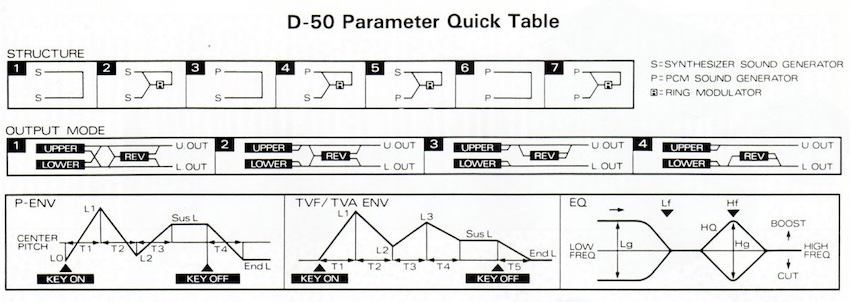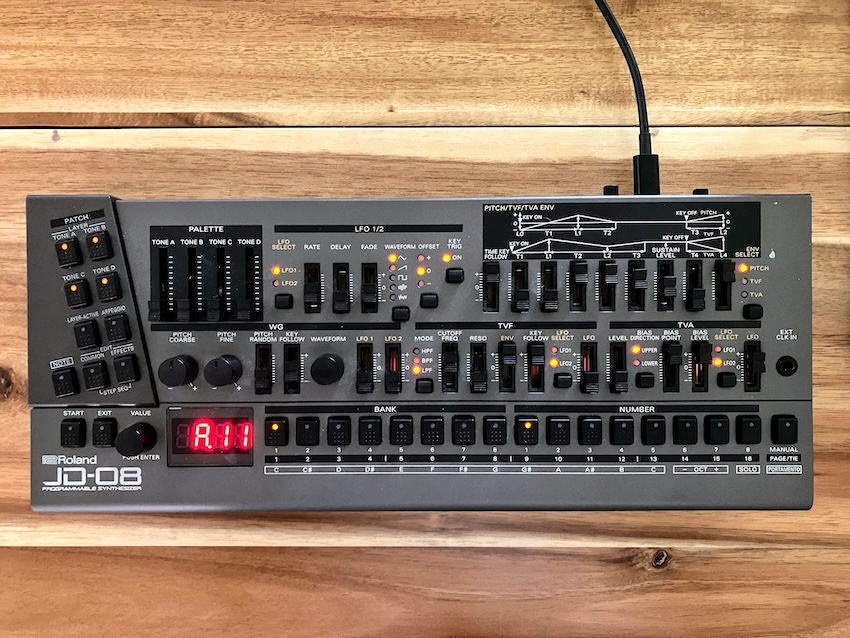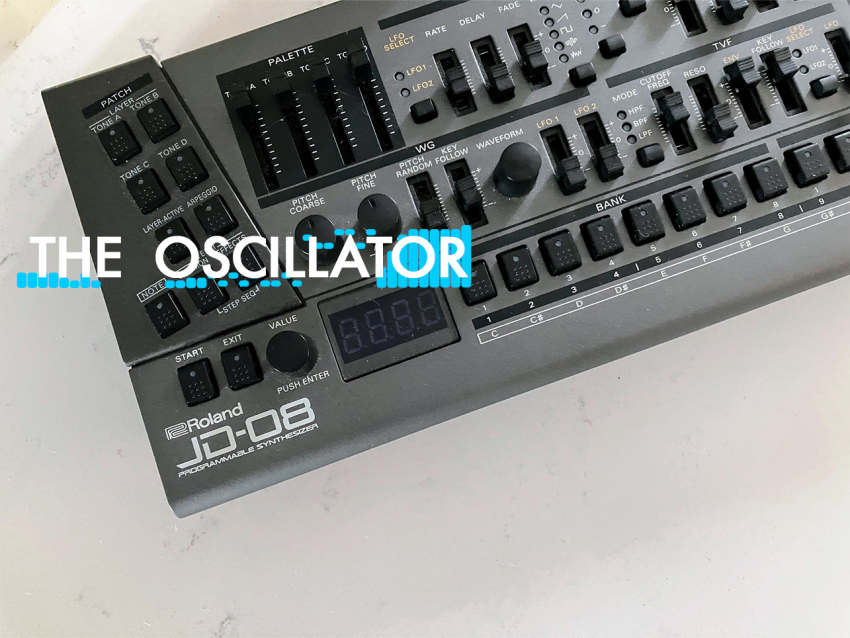I’ll be the first to admit, my first impression of Roland’s JD-08 was one of surprise. I thought: How would Roland fit all of its original inspiration into something smaller than your computer’s keyboard? That question drove me to give it a chance — I’d revive my niche of “The Oscillator” and share some thoughts on why now I think it’s worthy of your time. And to get started, let’s go back to 1991, when Roland launched the synth the JD-08 is based on: the JD-800.
In 1991, Roland launched the JD-800, designed by Kazuhisa Takahashi to bring back hands-on control in sound creation, a departure from the menu-driven interfaces of the time popular with synths like the Yamaha DX7 and Korg Poly800. Featuring 69 sliders, with four “palette” sliders dedicated to control various parameters at once, it allowed extensive real-time sound design, marking a significant shift from the digital synthesis trend. The JD-800 used an evolved form of Roland’s LA Synthesis, improving on the Roland D-50’s combination of PCM samples (dubbed “partials” in Roland-speak) and digital synthesis. It did so by introducing “loopable” samples, a higher sample rate, and dedicated chips for filters and effects, resulting in rich, dynamic sounds that went beyond the limitations of the D-50.
What is LA (Linear Arithmetic) Synthesis?
LA (Linear Arithmetic) synthesis is a hybrid sound synthesis method developed by Roland, that blends digital PCM (Pulse Code Modulation) samples with traditional subtractive synthesis techniques, as experienced on classic analog synths from Moog and others. Introduced with the D-50 in 1987, LA synthesis utilizes short sampled attacks combined with synthesized sustain phases, allowing for complex and realistic sound creation with a relatively small amount of memory. The sampled attacks provide the initial transients, while the subtractive synthesis shapes the sustain, release, and overall timbre.

Source: mu:zines
In theory, on a D-50, it allowed someone to easily dial in a certain sound – something piano-like, percussive-like, orchestral-like, and more – without having to spend tons of time sculpting it through oscillators and envelopes. In practice, its presence in Roland’s first fully-digital synth was hampered by the painstaking ’80s practice of hiding most editing functions through menu systems.
Building on this technology, the JD-800 further enhanced LA synthesis by offering loopable samples and multi-sampling, along with (most importantly) extensive real-time control through numerous sliders and buttons. This evolution enabled more detailed and expressive sound design instantly, maintaining the core principles of LA synthesis while providing a more intuitive and hands-on approach for those who wanted to build new tones.
The Programmable Digital Synth
Roland’s JD-800, with its 24-voice polyphony, leveraged its sound-shaping capabilities through subtractive synthesis parameters such as digital filters, multiple envelopes, and LFOs. Its high-quality effects and the ability to layer up to four tones per patch provided a deep, versatile sound palette. The CD-quality sample rate (found inside a whopping 4MB of solid state memory) and high-end D/A converters contributed to its distinct sound, setting it apart from other digital synths of the era. Its unique design, inspired by military hardware, featured an angled panel and a stealth bomber look, making it visually striking, ergonomic, and user-friendly. In some ways, it was the JD-800, alongside Korg’s M1 or Kurzweil’s K2000, that would pave the way for a specific kind of ’90s ROMpler-based music.

Source: Roland
However, compared to the Roland D-50, the JD-800’s incorporation of loopable and multi-samples, provided more realistic sustain and better tracking. While the D-50 was revolutionary with its blend of PCM samples and digital synthesis, the JD-800 had higher-quality waveforms and more sophisticated sound processing capabilities. Now musicians were free to chuck out their spreadsheet-looking patch books.
Musical Matters
So, what’s really possible with a JD-08? Hear how its inspiration has been used in iconic tracks:
The JD-800 found favor early among electronic musicians and notable artists like Prince, who used it extensively on Rave Un2 The Joy Fantastic, and Rick Wakeman, who appreciated its analog-style sound design. Despite not being a major commercial hit initially, it garnered a dedicated following and influenced subsequent Roland instruments such as the JD-990 and the JP-8000, which became studio mainstays.
On tracks like Spiritualized’s “Ladies And Gentlemen We Are Floating In Space” you can hear the gorgeous textures one could suss out of a JD-800, with its pads forming one (or many) important elements cycling around Jason Spaceman’s early floating atmospheric rock music.
In the ’90s, one couldn’t knock over a stack of VHS tapes without bumping into a cassette bearing Eric Persing’s iconic JD-800 patch, “Crystal Rhodes,” supplanting his earlier D-50 creation, “Fantasia,” as playing the plaintitive piano part on countless TV and film dramas. Although, if you ask me, I’m really partial to – no pun intended – SWV’s use of it on their classic ’90s slow jam, “Weak.”
However, the music most people associate with having that rich JD-800, LA-synthesized sound could have been what they heard at the club or at a rave. Whether you tuned in to the deep house sounds of 808 State, showed up at the aggro jungle of The Prodigy or stumbled onto the “Sponsored by United Colors of Benetton” after-party at the A Guy Called Gerald video set, there was no glow stick left unturned by the multi-layered sounds of this synth. Yet, I think what you can do with the JD-800 is best exemplified by Yoshihiro Sawasaki’s use of it in his Perfumed Garden or Ken Ishii’s on Jelly Tones.
Looking back, it’s no wonder Roland sought to revive this bit of synth history. Far from being a pastiche, their “boutique version” of it, the JD-08, distills the essence of what was already a forward-thinking synthesizer into something more fitting of our contemporary lifestyle.
A Closer Look at the JD-08
First, let’s focus on what’s new.

Highlights:
- 256 Patch Slots vs. 64 on the original
- 128-voice polyphony vs. 24 voices (using 1 tone) or 6-voice (using all 4 tones)
- Multitimbral (allowing two different two-part sound sequences to play independently)
- USB and external clock input (USB can send audio and clock syncs with Eurorack gear)
- On-board arpeggiator and sequencer
- Battery or USB-powered
- Built-in mini speaker
- No keybed
- Price: $400 vs. >$1500 on used original models
The Roland JD-08 offers key features not found on the JD-800, including 256 patch slots, 128-voice polyphony, multitimbral capability for independent two-part sequences, USB and external clock input, an on-board arpeggiator and sequencer, battery or USB power, and a built-in mini speaker. Despite lacking a keybed, it provides enhanced connectivity and portability at a fraction of the price of used JD-800 models.
Now let’s look at some of the “drawbacks” of the JD-08.
Trade-offs:
- A BIG ONE: you can’t import JD-800 patches or externally backup your JD-08 patches
- One 4-digit LCD screen vs. 40-digit x 2-line Dual-LCD screen on the original
- Shared Pitch, TVF, and TVA envelope control sections
- Shared LFO 1+2 Sections
- Aftertouch modulation controls from the original are gone in the JD-08
While the Roland JD-08 offers modern features and portability, it comes with some tradeoffs compared to the JD-800. A significant drawback is the inability to import JD-800 patches or externally backup JD-08 patches. The JD-08 features a single 4-digit LCD screen, whereas the JD-800 has a more detailed 40-character, dual-line LCD. In the JD-08, Pitch, TVF, and TVA envelope controls, as well as LFO 1 and 2 sections, are shared, reducing the ease of simultaneous adjustments, making you work twice or thrice as hard to quickly change a specific section. Additionally, the JD-08 lacks the aftertouch modulation controls found on the JD-800, limiting some expressive capabilities original users explored.
My hope: Roland finds a way to correct the Big Ones and allow JD-08 users to tap into the awesome collection of JD-800 sound libraries that once existed in ROM card form. Likewise, a handy editor and a way to back up its user banks would be beyond helpful.
So, who is the Roland JD-08 for?
Whenever you’re going to plunk down any hard-earned money, it’s good to assess what exactly it is going to do for you.
On close inspection, I think the JD-08 is perfect for any pop or dance musician trying to instantly capture a certain early ’90s music aesthetic without having to go digging through sample libraries or ponying up the money for “vintage” synths – like the M1 – from that era. For DAW-less musicians/performers, I hate that too many of the electronic instruments out there cater to more atonal or textural Eurorack-inspired musicians. I’ve always thought the strength of Roland’s Boutique Series could come from how much they lean into my favorite era of theirs: when they went all-in on digital. The JD-08 is pitch-perfect for pads but I think its tonal sounds still really cut through the mix.
With the JD-08, you get a synth that to this day sounds as future-forward and forward-thinking as its stealth bomber-esque design.
As for me, I was able to come up with a little, early summer-inspired tune solely using the JD-08’s impressive LA synthesis tones and mixed in a few field recordings to “humanize” it all.




Leave a Reply